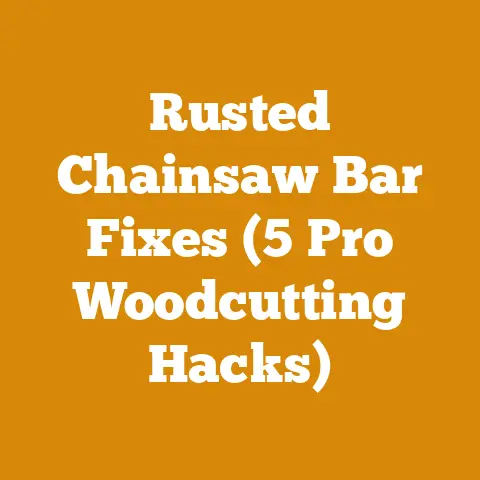Flooded Chainsaw Fixes (5 Expert Steps to Restart Fast)
Flooded Chainsaw Fixes: 5 Expert Steps to Restart Fast
A flooded chainsaw is a common problem, especially if you’re new to using them or if your saw has been sitting idle for a while.
Essentially, flooding happens when too much fuel enters the engine cylinder, making it difficult for the engine to ignite.
This can occur due to several reasons, including:
- Over-priming: Pushing the primer bulb too many times before starting the engine.
- Incorrect Starting Procedure: Not following the manufacturer’s recommended starting procedure.
- Choke Problems: Leaving the choke on for too long or using it incorrectly.
- Old or Contaminated Fuel: Fuel that has degraded over time or contains contaminants can cause flooding.
- Carburetor Issues: A malfunctioning carburetor can deliver too much fuel to the engine.
Understanding the cause of the flooding can help you prevent it from happening again in the future.
Now, let’s get into the steps to fix it.
Step 1: Understanding the Problem and Safety First
Before you start tinkering with your chainsaw, it’s crucial to understand what you’re dealing with and ensure your safety.
A flooded engine means there’s an excess of fuel in the cylinder, which can be a fire hazard if not handled correctly.
- Safety Precautions:
- Turn off the Chainsaw: Ensure the chainsaw is completely switched off.
- Cool Down: Let the engine cool down completely before attempting any repairs.
- Clear Area: Work in a well-ventilated area, away from any flammable materials.
- Wear Gloves: Wear gloves to protect your hands from fuel and oil.
- Eye Protection: Use safety glasses to prevent any debris or fuel from splashing into your eyes.
- Identifying Flooding:
- Smell of Fuel: A strong smell of gasoline is a telltale sign of a flooded engine.
- Wet Spark Plug: Removing the spark plug and checking for fuel on the electrode.
- Engine Refusal to Start: The engine cranks but fails to start, often accompanied by sputtering or a gurgling sound.
Step 2: The “No Choke” Starting Method
This is often the simplest and most effective method for restarting a flooded chainsaw.
The idea is to introduce more air into the cylinder to balance the fuel-air mixture.
Procedure:
- Turn off the Choke: Ensure the choke is in the “off” or “run” position.
This prevents more fuel from entering the engine. - Throttle Position: Hold the throttle wide open.
This allows maximum air intake while cranking the engine. - Pull the Starter Cord: Pull the starter cord repeatedly, but not violently.
You’re trying to clear the excess fuel from the cylinder, not start the engine immediately.
Usually, 5-10 pulls should be enough. - Listen Carefully: Listen for any signs of the engine trying to start.
If you hear sputtering or a slight rumble, it’s a good sign that the fuel is clearing. - Release Throttle: Once the engine shows signs of life, release the throttle and try starting the chainsaw normally.
- Turn off the Choke: Ensure the choke is in the “off” or “run” position.
-
Why it Works: Opening the throttle and turning off the choke allows a greater volume of air to enter the cylinder, diluting the fuel mixture and making it easier to ignite.
Step 3: Removing the Spark Plug and Drying it Out
If the “no choke” method doesn’t work, the next step is to remove the spark plug and manually clear the excess fuel.
Procedure:
- Locate the Spark Plug: The spark plug is usually located on the side of the engine, covered by a rubber boot.
- Remove the Boot: Gently pull off the rubber boot to expose the spark plug.
- Use a Spark Plug Wrench: Use a spark plug wrench to loosen and remove the spark plug.
Be careful not to damage the plug or the surrounding threads. - Inspect the Spark Plug: Examine the spark plug for signs of fouling (carbon buildup) or damage.
A wet spark plug confirms the engine is flooded. - Dry the Spark Plug: Thoroughly dry the spark plug with a clean rag or paper towel.
You can also use compressed air to blow out any remaining fuel. - Clear the Cylinder: With the spark plug removed, pull the starter cord several times to expel any remaining fuel from the cylinder.
- Reinstall the Spark Plug: Carefully reinstall the spark plug, tightening it securely with the spark plug wrench.
- Replace the Boot: Reattach the rubber boot to the spark plug.
- Attempt to Start: Try starting the chainsaw using the normal starting procedure.
-
Why it Works: Removing the spark plug allows you to physically remove the excess fuel from the cylinder and ensure the spark plug is dry and capable of producing a spark.
Step 4: Checking and Cleaning the Air Filter
A clogged or dirty air filter can restrict airflow to the engine, contributing to flooding.
Cleaning or replacing the air filter can improve engine performance and prevent future flooding issues.
Procedure:
- Locate the Air Filter: The air filter is usually located in a housing on the side or top of the engine.
- Remove the Air Filter Cover: Remove the cover to access the air filter.
- Inspect the Air Filter: Examine the air filter for dirt, debris, or damage.
- Clean the Air Filter:
- Foam Filters: Wash foam filters with warm soapy water, rinse thoroughly, and allow to dry completely.
You can also apply a small amount of air filter oil after cleaning. - Paper Filters: Gently tap paper filters to remove loose dirt and debris.
You can also use compressed air to blow out the filter from the inside out.
Avoid washing paper filters, as this can damage them.
- Foam Filters: Wash foam filters with warm soapy water, rinse thoroughly, and allow to dry completely.
- Replace the Air Filter: If the air filter is damaged or excessively dirty, replace it with a new one.
- Reinstall the Air Filter: Carefully reinstall the air filter and replace the cover.
- Attempt to Start: Try starting the chainsaw using the normal starting procedure.
-
Why it Works: A clean air filter allows the engine to breathe properly, ensuring the correct air-fuel mixture for efficient combustion.
Step 5: Inspecting the Carburetor (Advanced)
If the previous steps haven’t resolved the flooding issue, the problem might lie within the carburetor.
The carburetor is responsible for mixing air and fuel in the correct proportions, and a malfunctioning carburetor can cause excessive fuel delivery.
This step requires some mechanical knowledge, and if you’re not comfortable working on carburetors, it’s best to take your chainsaw to a qualified repair technician.
Procedure (for those with mechanical experience):
- Locate the Carburetor: The carburetor is usually located between the air filter and the engine cylinder.
- Inspect the Carburetor: Visually inspect the carburetor for any signs of damage, leaks, or loose connections.
- Check the Fuel Lines: Ensure the fuel lines are securely attached and not cracked or damaged.
- Check the Carburetor Adjustment Screws: The carburetor has adjustment screws that control the fuel-air mixture.
These screws may be labeled “H” (high speed) and “L” (low speed).
Avoid adjusting these screws unless you know what you’re doing, as incorrect adjustments can cause further problems. - Clean the Carburetor (if necessary): If you suspect the carburetor is dirty or clogged, you can try cleaning it with carburetor cleaner.
Disassemble the carburetor carefully, following the manufacturer’s instructions, and spray all the components with carburetor cleaner.
Reassemble the carburetor and reinstall it on the engine. - Adjust the Carburetor (if necessary): If you’re comfortable adjusting the carburetor, you can try fine-tuning the adjustment screws to optimize the fuel-air mixture.
Refer to the manufacturer’s instructions for the correct adjustment procedure. - Attempt to Start: Try starting the chainsaw using the normal starting procedure.
-
Why it Works: A properly functioning carburetor ensures the correct fuel-air mixture, preventing flooding and ensuring efficient engine operation.
Cost Considerations and Budgeting for Chainsaw Maintenance
Now that we’ve covered how to fix a flooded chainsaw, let’s talk about the costs associated with chainsaw maintenance and how to budget for them.
As someone who relies on chainsaws for both professional and personal use, I can tell you that neglecting maintenance can lead to costly repairs and downtime.
Initial Investment: Chainsaw Purchase Price
The initial cost of a chainsaw can vary widely depending on the type, size, and brand.
Here’s a general breakdown:
- Entry-Level Chainsaws (Electric or Small Gas): \$100 – \$300
- Mid-Range Chainsaws (Gas-Powered, 16-18 inch bar): \$300 – \$600
- Professional-Grade Chainsaws (Gas-Powered, 20+ inch bar): \$600 – \$1500+
Data Point: According to a report by Statista, the average price of a chainsaw in the United States in 2023 was around \$450.
This figure includes both consumer-grade and professional-grade models.
My Experience: I started with a mid-range Stihl chainsaw about 15 years ago, and it served me well for many years.
I eventually upgraded to a professional-grade Husqvarna for larger logging jobs.
The initial investment was higher, but the increased power and durability have paid off in the long run.
Ongoing Maintenance Costs
The ongoing maintenance costs for a chainsaw can be significant, especially if you use it frequently.
Here’s a breakdown of the common expenses:
- Fuel: Chainsaws typically use a mixture of gasoline and oil.
The cost of fuel can vary depending on the price of gasoline and the type of oil you use.- Gasoline: Average price per gallon (premium grade recommended): \$3.50 – \$5.00 (depending on location and market conditions).
- 2-Cycle Oil: Average price per quart: \$10 – \$20 (synthetic blends are generally recommended for better engine protection).
- Chain Oil: Chain oil is essential for lubricating the chain and bar, reducing friction and preventing wear.
- Average Price per Gallon: \$15 – \$30 (bar and chain oil).
- Chain Sharpening: A sharp chain is crucial for efficient cutting and safety.
You can sharpen the chain yourself with a file or use a professional sharpening service.- DIY Sharpening File: \$10 – \$20
- Professional Sharpening Service: \$10 – \$20 per sharpening.
- Air Filter Replacement: Air filters should be replaced regularly to ensure proper airflow to the engine.
- Average Price: \$5 – \$15 per filter.
- Spark Plug Replacement: Spark plugs should be replaced periodically to ensure reliable ignition.
- Average Price: \$5 – \$10 per spark plug.
- Chain Replacement: Chains wear out over time and need to be replaced.
- Average Price: \$20 – \$50 per chain (depending on length and type).
- Bar Replacement: The bar can also wear out over time, especially if it’s not properly lubricated.
- Average Price: \$30 – \$100 per bar (depending on length and type).
- Carburetor Cleaning or Replacement: Carburetor issues can be costly to repair.
- Carburetor Cleaning: \$50 – \$100 (professional service).
- Carburetor Replacement: \$100 – \$300 (including labor).
- Other Repairs: Other potential repairs include engine problems, starter issues, and fuel line replacements.
These costs can vary widely depending on the severity of the problem.- Average Hourly Labor Rate for Chainsaw Repair: \$60 – \$100.
Data Point: According to data from various repair shops, the average annual maintenance cost for a chainsaw used regularly (e.g., for firewood cutting or occasional logging) is between \$50 and \$200.
This figure excludes major repairs.
Budgeting for Chainsaw Maintenance
Here’s a practical approach to budgeting for chainsaw maintenance:
- Estimate Usage: Determine how often you’ll be using your chainsaw.
Will it be for occasional home use, regular firewood cutting, or professional logging? - Create a Maintenance Schedule: Develop a maintenance schedule based on the manufacturer’s recommendations and your usage patterns.
This should include tasks like chain sharpening, air filter cleaning, spark plug replacement, and chain lubrication. - Allocate Funds: Allocate funds for each maintenance task based on the estimated costs.
For example:- Fuel and Oil: Estimate your fuel consumption based on your usage and allocate funds accordingly.
- Chain Sharpening: Set aside money for professional sharpening or invest in a sharpening file.
- Replacement Parts: Allocate funds for replacement parts like air filters, spark plugs, and chains.
- Emergency Fund: Set aside an emergency fund for unexpected repairs.
A good rule of thumb is to allocate 10-20% of your total maintenance budget for emergencies. - Track Expenses: Keep track of your maintenance expenses to ensure you’re staying within your budget.
Example Budget (for a chainsaw used for regular firewood cutting):
- Fuel and Oil: \$100 per year
- Chain Sharpening: \$40 per year (2 professional sharpenings)
- Air Filter Replacement: \$10 per year
- Spark Plug Replacement: \$5 per year
- Chain Replacement: \$30 per year
- Emergency Fund (10%): \$18.50 per year
Total Annual Maintenance Budget: \$203.50
Cost Optimization Tips
Here are some practical tips for optimizing your chainsaw maintenance costs:
- Perform Regular Maintenance: Regular maintenance can prevent costly repairs down the road.
- Sharpen Your Own Chain: Learning to sharpen your own chain can save you money on professional sharpening services.
- Use High-Quality Fuel and Oil: Using high-quality fuel and oil can extend the life of your engine and reduce the risk of problems.
- Clean Your Air Filter Regularly: A clean air filter improves engine performance and reduces fuel consumption.
- Store Your Chainsaw Properly: Store your chainsaw in a dry, clean place to prevent corrosion and damage.
- Buy Parts in Bulk: Buying replacement parts in bulk can save you money on individual items.
- Consider Refurbished Parts: Refurbished parts can be a cost-effective alternative to new parts.
- Shop Around for Repair Services: Get quotes from multiple repair shops before committing to a service.
- Learn Basic Repair Skills: Learning basic repair skills can save you money on labor costs.
My Story: I once neglected to clean the air filter on my chainsaw for an extended period, and it ended up causing the engine to overheat and seize.
The repair cost me over \$300, which could have been avoided if I had simply cleaned the air filter regularly.
Lesson learned!
The Cost of Downtime
It’s important to consider the cost of downtime when budgeting for chainsaw maintenance.
If your chainsaw breaks down in the middle of a job, it can delay your project and cost you money.
- Lost Productivity: If you’re using your chainsaw for professional purposes, downtime can result in lost productivity and reduced income.
- Project Delays: If you’re using your chainsaw for personal projects, downtime can delay your project and cause frustration.
- Rental Costs: If your chainsaw is out of commission, you may need to rent a replacement, which can be expensive.
Data Point: According to a study by the Associated Equipment Distributors, the average cost of equipment downtime in the construction industry is over \$1,000 per day.
While this figure is for larger equipment, it highlights the significant financial impact of downtime.
Chainsaw Rental Fees
If you don’t want to invest in a chainsaw or if you only need one for occasional use, renting a chainsaw can be a cost-effective option.
- Average Rental Fees:
- Half-Day Rental: \$30 – \$50
- Full-Day Rental: \$50 – \$80
- Weekly Rental: \$200 – \$300
Factors Affecting Rental Fees:
- Chainsaw Size and Type: Larger, more powerful chainsaws typically cost more to rent.
- Rental Duration: Longer rental periods usually result in lower daily rates.
- Location: Rental fees can vary depending on your location and the availability of chainsaws.
- Rental Company: Different rental companies may have different pricing structures.
My Tip: When renting a chainsaw, be sure to inspect it thoroughly before you leave the rental shop.
Check for any signs of damage or wear, and make sure the chain is sharp.
Also, ask about the rental company’s policies regarding maintenance and repairs.
Timber Prices and Firewood Market Rates
For those involved in logging or firewood preparation, understanding timber prices and firewood market rates is crucial for budgeting and profitability.
- Timber Prices: Timber prices can vary widely depending on the species, quality, and location.
- Softwood Lumber: Average price per thousand board feet (MBF): \$300 – \$600 (depending on species and grade).
- Hardwood Lumber: Average price per MBF: \$500 – \$1500+ (depending on species and grade).
- Firewood Market Rates: Firewood prices are typically measured in cords.
A cord is a stack of wood measuring 4 feet high, 4 feet wide, and 8 feet long.- Average Price per Cord: \$150 – \$400 (depending on location, wood species, and drying time).
Data Point: According to the U.S.
Energy Information Administration, the average price of firewood in the United States in 2023 was around \$250 per cord.
However, prices can vary significantly depending on the region.
Factors Affecting Timber and Firewood Prices:
- Wood Species: Hardwoods like oak and maple typically fetch higher prices than softwoods like pine and fir.
- Wood Quality: Wood that is free of knots, rot, and other defects is more valuable.
- Location: Timber and firewood prices can vary depending on the local market conditions and transportation costs.
- Seasonality: Firewood prices typically increase during the winter months when demand is higher.
- Drying Time: Seasoned firewood (wood that has been dried for at least six months) is more valuable than green wood.
Estimating Drying Time for Firewood
Drying time is a crucial factor in firewood preparation, as seasoned firewood burns more efficiently and produces less smoke.
-
Factors Affecting Drying Time:
- Wood Species: Hardwoods generally take longer to dry than softwoods.
- Climate: Warm, dry climates are ideal for drying firewood.
- Stacking Method: Stacking firewood in a way that allows for good air circulation can speed up the drying process.
- Wood Size: Smaller pieces of wood dry faster than larger pieces.
-
General Guidelines:
- Softwoods: 6-9 months
- Hardwoods: 12-18 months
Formula for Estimating Drying Time: While there’s no precise formula, you can estimate drying time based on the initial moisture content of the wood and the average humidity in your area.
A rough estimate can be:- Drying Time (months) = (Initial Moisture Content – Target Moisture Content) / Drying Rate
Where:
- Initial Moisture Content is the moisture content of the freshly cut wood (typically 50-60% for hardwoods).
- Target Moisture Content is the desired moisture content for seasoned firewood (around 20%).
- Drying Rate is the average monthly moisture loss (this varies depending on climate, but a rough estimate is 5-10% per month in a dry climate).
Example:
- Initial Moisture Content: 60%
- Target Moisture Content: 20%
- Drying Rate: 8% per month
Drying Time = (60 – 20) / 8 = 5 months
Note: This is just a rough estimate, and actual drying times may vary.
Case Study: Budgeting for a Small-Scale Firewood Business
Let’s consider a case study of someone starting a small-scale firewood business.
-
Assumptions:
- Goal: To sell 50 cords of firewood per year.
- Wood Source: Purchasing standing timber from a local landowner.
- Equipment: Existing chainsaw and splitter.
-
Cost Breakdown:
- Timber Purchase: \$50 per cord (standing timber) x 50 cords = \$2500
- Chainsaw Fuel and Oil: \$100 per year
- Splitter Fuel: \$50 per year
- Chainsaw Maintenance: \$100 per year
- Splitter Maintenance: \$50 per year
- Advertising: \$100 per year
- Transportation: \$200 per year
- Permits and Licenses: \$50 per year
-
Total Costs: \$3200
-
Revenue:
- Selling Price per Cord: \$250
- Total Revenue: \$250 x 50 cords = \$12,500
-
Profit: \$12,500 – \$3200 = \$9300
Analysis: This case study shows that a small-scale firewood business can be profitable, but it’s important to carefully budget for all expenses.
The biggest cost is the timber purchase, so finding a reliable and affordable source of wood is crucial.
Chainsaw Safety and Preventing Flooding
While fixing a flooded chainsaw is important, preventing it in the first place is even better.
Here are some safety tips and best practices to avoid flooding:
- Follow the Manufacturer’s Instructions: Always follow the manufacturer’s recommended starting procedure.
- Avoid Over-Priming: Only prime the engine a few times, as excessive priming can cause flooding.
- Use the Choke Correctly: Use the choke only when starting a cold engine, and turn it off as soon as the engine starts.
- Use Fresh Fuel: Use fresh, high-quality fuel and oil.
Old or contaminated fuel can cause flooding and other engine problems. - Store Fuel Properly: Store fuel in a cool, dry place, away from direct sunlight.
- Maintain Your Chainsaw: Regular maintenance can prevent flooding and other issues.
- Wear Protective Gear: Always wear appropriate protective gear, including safety glasses, gloves, and hearing protection.
- Be Aware of Your Surroundings: Be aware of your surroundings and avoid cutting in hazardous conditions.
- Take Breaks: Take regular breaks to avoid fatigue and maintain focus.
- Get Training: If you’re new to using a chainsaw, consider taking a training course to learn proper techniques and safety procedures.
My Recommendation: I always add a fuel stabilizer to my gasoline, especially when I know the chainsaw will be sitting unused for a while.
This helps prevent the fuel from degrading and causing problems.
Actionable Takeaways and Next Steps
You’ve now got a solid understanding of how to fix a flooded chainsaw and how to budget for chainsaw maintenance.
Here are some actionable takeaways and next steps:
- Review Your Chainsaw’s Manual: Familiarize yourself with the specific starting procedure and maintenance requirements for your chainsaw model.
- Create a Maintenance Schedule: Develop a maintenance schedule based on your usage patterns and the manufacturer’s recommendations.
- Gather Supplies: Stock up on essential supplies like fuel, oil, air filters, spark plugs, and chain sharpening tools.
- Practice the “No Choke” Starting Method: Practice the “no choke” starting method to prepare for future flooding incidents.
- Learn Basic Repair Skills: Consider learning basic repair skills to save money on labor costs.
- Budget for Maintenance: Create a budget for chainsaw maintenance and track your expenses.
- Prioritize Safety: Always prioritize safety when using and maintaining your chainsaw.
- Consider Professional Help: Don’t hesitate to seek professional help if you’re not comfortable performing certain repairs.
- Stay Informed: Stay informed about the latest chainsaw technology and maintenance techniques.
- Share Your Knowledge: Share your knowledge with others and help them avoid common chainsaw problems.
By following these steps, you can keep your chainsaw running smoothly and efficiently for years to come.
Remember, a well-maintained chainsaw is not only more reliable but also safer to use.
Now, go forth and conquer those wood processing and firewood preparation projects with confidence!






